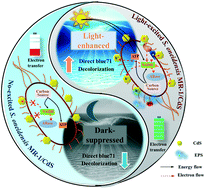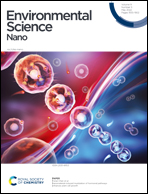A light-switch for efficient decolorization of azo dye wastewater based on bacteria–semiconductor interaction†
Abstract
Understanding how semiconductors interface with bacteria has become increasingly important in environmental remediation. Herein, Shewanella oneidensis MR-1/CdS was constructed, and the interaction between S. oneidensis MR-1 and CdS in decolorization of azo dye wastewater was studied. Compared with S. oneidensis MR-1, direct blue 71 (DB71) decolorization efficiency of S. oneidensis MR-1/CdS was light-enhanced 4.04 times and dark-suppressed 2.18 times. CV, DPV, EIS and Tafel analysis showed that the S. oneidensis MR-1/CdS interface electron transfer was light-activated. The improvement of bioelectron generation (NADH), cell energy levels (ATP), and photoelectron separation and the increase of electron transfer rate enhanced the effective decolorization of azo dye by S. oneidensis MR-1/CdS. Moreover, this study demonstrated that outer-membrane proteins, NADH dehydrogenase and menaquinone were essential for interface electron transfer. Therefore, a light-switch mechanism of S. oneidensis MR-1/CdS was elucidated from electron generation, electron transfer and energy levels. Furthermore, a feasibility study was conducted using natural sunlight for DB71 decolorization by S. oneidensis MR-1/CdS, which showed excellent decolorization efficiency and unique low-temperature advantages. These findings expand our knowledge of the interaction among semiconductors, bacteria and light irradiation, and lay the foundation for further environmental remediation applications.

- This article is part of the themed collection: Environmental Remediation


 Please wait while we load your content...
Please wait while we load your content...